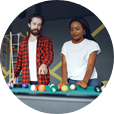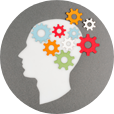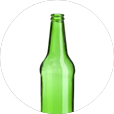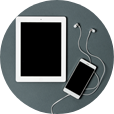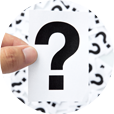No Table, No Problem: How to Practice Pool Without a Table

Have you ever wanted to get better at pool but found yourself without access to a pool table? It might seem impossible to practice without the actual table and balls, but there's good news — you can still improve your skills! Learning how to practice pool without a table is not only possible but also quite effective.
Practicing pool without a table might sound strange at first, but it's all about focusing on the fundamentals. By working on your stance, grip, aiming, and stroke, you can build a strong foundation that will make you a better player when you return to the table. Plus, you can do plenty of exercises and techniques at home to keep your skills sharp. It's a great way to learn how to be good at pool.
Understanding the Basics: How To Get Better at Pool Without a Pool Table
Before diving into advanced techniques, it's crucial to master the fundamentals of pool. Understanding these basics will create a solid foundation for your game so you can improve over time. You can still work on these essential skills even if you don't have a pool table.
First, let's talk about stance. Your stance is how you position yourself when taking a shot. A good stance provides balance and stability, allowing for a smooth and controlled stroke. Practice standing with your feet shoulder-width apart, bending slightly at the knees, and keeping your body relaxed.
Next up is grip. How you hold the cue stick affects your control and accuracy. Hold the cue lightly, like you're shaking hands with it, and make sure your grip is relaxed. You don't need to squeeze it tightly; a gentle hold will give you better control.
Aiming is another critical aspect of pool. To practice aiming without a table, you can use household items like a rolled-up towel or a piece of string to simulate the line of the shot. Stand behind your "cue ball" (anything from a small ball to a coin) and practice aligning your shot. Visualizing the path of the ball helps improve your accuracy.
Finally, let's discuss stroke. This is the motion you use to hit the cue ball. A smooth, consistent stroke is crucial in making accurate shots. Focus on keeping your movement steady and controlled, which will help you develop muscle memory.
By focusing on these fundamentals — stance, grip, aiming, and stroke — you can significantly improve your game. Understanding how to get better at pool without a pool table is all about mastering these basics. Practice them regularly, and you'll find that your skills will improve, even without the actual table and balls.
Visualization Techniques: How To Practice Pool by Yourself
Visualization is a powerful tool athletes use in many sports, including pool. It involves imagining yourself playing the game, making shots, and winning matches. Studies have shown this mental practice can be just as effective as physical practice, helping you improve your skills and confidence.
So, how do you visualize a pool game? Start by finding a quiet place where you can relax without distractions. Close your eyes and take a few deep breaths to clear your mind. Now, picture yourself standing at the pool table, holding your cue stick. Imagine the feel of the stick in your hands and the sight of the balls on the table.
Next, think about the shot you want to make. Visualize the cue ball hitting the target ball and see it rolling into the pocket. Try to make the image as clear and detailed as possible. Imagine the sound of the balls clicking together and the satisfaction of making a successful shot.
Repeat this process for different shots and scenarios. Visualize yourself breaking the rack, making difficult shots, and winning games. The more detailed and realistic your mental images, the more effective this technique will be.
Visualization can help you improve your game in several ways. First, it reinforces the techniques and strategies you need to play well. Mentally practicing your shots trains your brain to remember the correct movements and decisions. Second, it boosts your confidence. Seeing yourself succeed in your mind can make you feel more capable and prepared when you're actually playing.
Practicing pool by yourself using visualization is a great way to stay sharp and improve your skills. You can still work on your game and build your confidence even without a table. So, take a few minutes each day to visualize your shots and imagine yourself playing your best. You'll be surprised at how much this simple technique can help you get better at pool.
Practicing Stance and Stroke
Getting your stance and stroke right is essential for playing good pool. Even if you don't have a pool table, you can still practice these basics at home. Here's how you can work on your stance and stroke without needing a table.
First, let's talk about your stance. Your stance is how you position your body when you're getting ready to take a shot. To practice this:
- Find a space where you can stand comfortably.
- Bend your knees slightly and place your feet shoulder-width apart
- Keep your body relaxed but stable.
Now, let's move on to your stroke. Stand in your stance and practice the motion of hitting the cue ball. Focus on keeping your movement smooth and controlled. You want to develop a consistent stroke you can rely on during a game.
Here are a few exercises to help you improve your stance and stroke:
- Mirror Practice: Take your stance in front of a mirror. Practice your stroke while watching yourself. This will help you see if your posture and movement are correct.
- Slow Motion: Practice your stroke in slow motion. This helps you focus on each part of the movement and make sure it's smooth and controlled.
- Repetition: Repeat your stance and stroke practice regularly. The more you practice, the more natural it will feel. This repetition helps build muscle memory so your body knows what to do without you having to think about it.
The Classic Bottle Drill
If you want to learn how to practice pool without a table, try the bottle drill. For this exercise, you'll need a towel and a clean, dry bottle to keep the cue's leather tip safe. Grab your cue stick and use these items to identify and fix any mistakes in your technique.
Here's how to do it:
- Place the towel on a table and set the bottle on top to keep it steady.
- Adjust the towel's position based on the type of shot you want to practice. For example, if you need to work on hitting the lower center of the ball, you can tilt the bottle slightly.
- Check your stance and alignment each time you take a shot. Ensure your posture and technique are consistent, like in a real game.
- Pay attention to your body's position as you practice your strokes, especially at the end of each shot. The goal of this drill is to ensure that your cue stick goes straight into the bottle without touching it, except at the end of your follow-through. If you hit the bottle, it means your stroke isn't straight, so you'll need to adjust.
This drill can also help you spot other issues. For instance, if you keep hitting the top of the bottle, you might be dropping your elbow too low. If you frequently hit the sides of the bottle, it could indicate problems with your stance. Don't worry; the solution is simple. Just slow down your stroke and delivery to gain better control.

Using Technology and Apps
In today's digital age, there's an app for almost everything, and pool is no exception. Even if you don't have access to a pool table, you can still practice and improve your skills using technology and online resources.
There are plenty of pool training apps available that can help you practice different aspects of the game. Some apps offer virtual pool tables where you can practice your shots and strategies. Others provide tutorials, drills, and tips to help you improve your technique. These apps are great because they let you practice pool anytime, anywhere.
Online resources like YouTube are also a goldmine for pool players. You can find videos from professional players and coaches sharing their tips and tricks. Watching these videos can give you new insights and help you understand different techniques better.
Virtual tools can be incredibly helpful for practicing pool. For example, some apps use augmented reality (AR) to show you the angles and paths of your shots. This can help you visualize your shots better and understand how to aim more accurately. There are also apps with interactive drills that guide you through different exercises, making your practice sessions more structured and effective.
Frequently Asked Questions About How To Practice Pool Without a Table
FCI Billiards is more than an excellent source for pool cues, pool cue tips, and cue balls. We're also a trusted source of information. Here are some of the most common questions we receive.
Are There Portable Pool Cue Accessories That Can Aid in Off-Table Practice?
Yes, there are portable pool cue accessories that can help you practice off-table. A cue ball can be useful, and we offer several billiard training aids that you might find helpful.
How Can I Simulate Game Scenarios and Pressure Situations When Practicing Without a Table?
Simulating game scenarios and pressure situations without a table can be challenging, but it's definitely possible. To help you prepare, you can try visualization, timed drills, and mindfulness exercises.
What Mental Aspects of Pool Can I Work on During Off-Table Practice?
Off-table practice is an excellent opportunity to work on the mental aspects of pool, which are just as important as physical skills. Here are some key areas to focus on:
- Concentration: Practice techniques to improve your focus and concentration. This can include meditation, mindfulness exercises, or simply practicing staying present in the moment.
- Visualization: Regularly visualizing successful shots and game scenarios can boost your confidence and mental clarity.
- Strategy: Study different game strategies and shot selections. Understanding the strategic aspects of pool can help you make better decisions during actual games.
- Mental Toughness: Work on building mental resilience. This can include setting goals, developing a positive mindset, and learning how to stay calm under pressure.
- Self-Reflection: Take time to reflect on your practice sessions and identify areas for improvement. This self-awareness can help you adjust and continue growing as a player.
Order Pool Cues and Accessories From FCI Billiards
Now that you know how to practice pool without a table, you're ready for the next step. Dial in your pool game with cues and accessories from FCI Billiards. We offer many products to help you enjoy the game and improve your skills. Shop now and experience everything FCI Billiards offers.
Related Articles
 How to Hold a Pool Stick
(the
Right Way)
How to Hold a Pool Stick
(the
Right Way)
Discover techniques to achieve an effective and comfortable grip when you hold a pool cue to elevate your game.
 How to Get Better at Pool
How to Get Better at Pool
Learn tips and tricks for pool practice to improve your billiard skills and shot selection at the table.
 Finding Your Perfect Balance: How to Choose the Right Pool Cue Weight
Finding Your Perfect Balance: How to Choose the Right Pool Cue Weight
The weight of your pool cue directly affects your success as a billiards player. Our guide breaks down everything you need to know about selecting the best pool cue weight.
Recent Posts
-
January 22, 2025 By FCI Billiards When your game has progressed beyond the basics, it may be ti …Jan 22nd 2025
-
December 6, 2024 By FCI Billiards …Dec 6th 2024
-
July 29 2025 By FCI Billiards Taking on a new sport can be a little intimidating, particularly if …Nov 5th 2024

